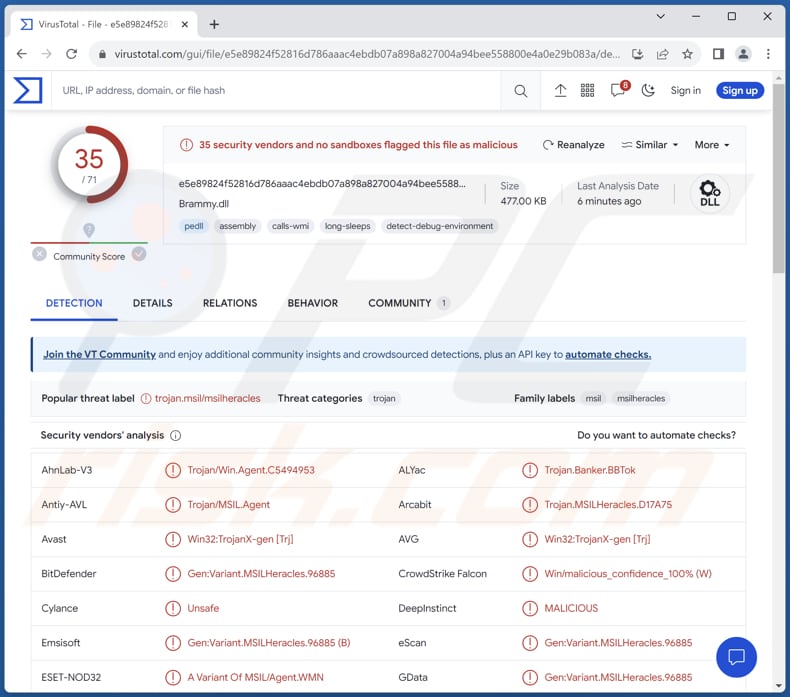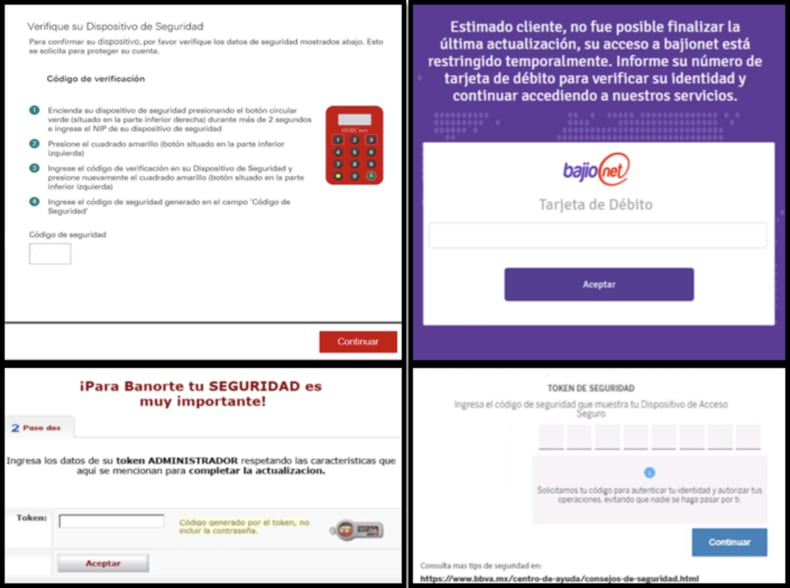How to remove BBTok malware from the operating system
![]() Written by Tomas Meskauskas on (updated)
Written by Tomas Meskauskas on (updated)
What kind of malware is BBTok?
The BBTok is a banking Trojan written in Delphi equipped with specialized functionality that mimics the interfaces of over 40 Mexican and Brazilian banks. Its deceptive tactics involve luring victims into divulging their 2FA codes for bank accounts or their payment card numbers.
Additionally, BBTok boasts capabilities such as process enumeration and termination, control over keyboard and mouse functions, and manipulation of clipboard contents.

More about BBTok
BBTok provides threat actors with extensive functionalities, encompassing both remote commands and conventional banking Trojan features. It excels in replicating the interfaces of numerous Latin American banks, with code references to more than 40 prominent banks in Mexico and Brazil, including Citibank, Scotiabank, Banco Itaú, and HSBC.
BBTok scans open windows and browser tab names to identify potential victims, searching for any references to these specific banks among its targets. The primary target of BBTok appears to be BBVA, as it defaults to replicating the appearance of this bank in its fake interface. These counterfeit interfaces impersonate genuine financial institutions, deceiving users into sharing their personal and financial information.
The primary objective of this functionality is to deceive the victim into entering their security code or token number, typically used as two-factor authentication (2FA) for bank accounts. This enables the attacker to carry out unauthorized account takeovers. Additionally, in certain instances, this capability also aims to dupe the victim into disclosing their payment card number.
BBTok utilizes the Visual Component Library (VCL) to craft these fake interfaces. This enables attackers to dynamically generate interfaces that seamlessly match the victim's screen and mimic the chosen bank's form.
In addition to targeting banking sites, the attackers have adapted to current trends and now actively seek information related to Bitcoin on the compromised machine. They actively search for specific terms such as "bitcoin", "electrum", and "binance".
BBTok does not limit itself to visual deception. It can install a harmful browser extension or inject a specific DLL to strengthen its control over the compromised system, potentially enhancing its ability to deceive victims.
Furthermore, BBTok exhibits other functionalities, including the ability to enumerate and terminate processes running on the infected system. This grants the attacker control over the computer's processes, potentially allowing them to disrupt essential functions or inject malicious code.
BBTok also empowers the attacker with control over keyboard and mouse functions, which can be exploited for unauthorized actions, such as keystroke logging or mouse-click simulation. Additionally, the malware can manipulate clipboard contents, potentially enabling it to intercept and modify copied data, which could include sensitive information like passwords or payment details.
| Name | BBTok banking trojan |
| Threat Type | Banking Trojan, Banking Malware |
| Detection Names | Avast (Win32:TrojanX-gen [Trj]), Combo Cleaner (Gen:Variant.MSILHeracles.96885), ESET-NOD32 (A Variant Of MSIL/Agent.WMN), Kaspersky (HEUR:Trojan.MSIL.Agent.gen), Microsoft (TrojanDownloader:MSIL/Tnega!MSR), Full List (VirusTotal) |
| Symptoms | Banking Trojans are designed to stealthily infiltrate the victim's computer and remain silent, and thus no particular symptoms are clearly visible on an infected machine. |
| Distribution methods | Infected email attachments, malicious online advertisements, social engineering, software 'cracks'. |
| Damage | Stolen passwords and banking information, identity theft, monetary loss, possible additional infections, privacy breaches, and more. |
| Malware Removal (Windows) | To eliminate possible malware infections, scan your computer with legitimate antivirus software. Our security researchers recommend using Combo Cleaner. |
Conclusion
In conclusion, BBTok is a multifaceted malware strain designed to infiltrate and compromise victims' systems, focusing on banking fraud. Its ability to replicate the interfaces of numerous Latin American banks and its advanced features like process control, keyboard and mouse manipulation, and clipboard manipulation make it a potent threat to individual users and financial institutions.
How did BBTok infiltrate my computer?
In order to propagate BBTok and execute their campaign efficiently, cybercriminals have devised a distinct method that commences when a victim unwittingly clicks on a malicious link, typically distributed through phishing emails. Once the victim clicks on this deceptive link, it triggers the download of either a ZIP archive or an ISO image tailored to the victim's specific operating system.
Remarkably, this process remains invisible to the victim. Behind the scenes, however, the server dynamically generates a unique payload based on parameters identified within the request, ensuring that the malware is optimized for the victim's system, thereby facilitating the seamless infection process.
How to avoid installation of malware?
Exercise caution with emails. Be careful when opening email attachments or links, especially from unknown or suspicious addresses. Avoid interacting with files or links in emails that seem unusual or unexpected. Refrain from downloading software or files from untrusted sources, especially those promoting pirated content or cracked applications.
Do not trust ads, pop-ups, and links on dubious websites. Use official pages and stores as sources for obtaining programs and files. Keep your operating system, installed software, and security programs up to date. Utilize reliable antivirus and anti-malware software.
If you believe that your computer is already infected, we recommend running a scan with Combo Cleaner Antivirus for Windows to automatically eliminate infiltrated malware.
BBTok displays fake interfaces (source: checkpoint.com):

Instant automatic malware removal:
Manual threat removal might be a lengthy and complicated process that requires advanced IT skills. Combo Cleaner is a professional automatic malware removal tool that is recommended to get rid of malware. Download it by clicking the button below:
▼ DOWNLOAD Combo Cleaner
By downloading any software listed on this website you agree to our Privacy Policy and Terms of Use. To use full-featured product, you have to purchase a license for Combo Cleaner. 7 days free trial available. Combo Cleaner is owned and operated by Rcs Lt, the parent company of PCRisk.com read more.
Quick menu:
How to remove malware manually?
Manual malware removal is a complicated task - usually it is best to allow antivirus or anti-malware programs to do this automatically. To remove this malware we recommend using Combo Cleaner Antivirus for Windows.
If you wish to remove malware manually, the first step is to identify the name of the malware that you are trying to remove. Here is an example of a suspicious program running on a user's computer:

If you checked the list of programs running on your computer, for example, using task manager, and identified a program that looks suspicious, you should continue with these steps:
 Download a program called Autoruns. This program shows auto-start applications, Registry, and file system locations:
Download a program called Autoruns. This program shows auto-start applications, Registry, and file system locations:

 Restart your computer into Safe Mode:
Restart your computer into Safe Mode:
Windows XP and Windows 7 users: Start your computer in Safe Mode. Click Start, click Shut Down, click Restart, click OK. During your computer start process, press the F8 key on your keyboard multiple times until you see the Windows Advanced Option menu, and then select Safe Mode with Networking from the list.

Video showing how to start Windows 7 in "Safe Mode with Networking":
Windows 8 users: Start Windows 8 is Safe Mode with Networking - Go to Windows 8 Start Screen, type Advanced, in the search results select Settings. Click Advanced startup options, in the opened "General PC Settings" window, select Advanced startup.
Click the "Restart now" button. Your computer will now restart into the "Advanced Startup options menu". Click the "Troubleshoot" button, and then click the "Advanced options" button. In the advanced option screen, click "Startup settings".
Click the "Restart" button. Your PC will restart into the Startup Settings screen. Press F5 to boot in Safe Mode with Networking.

Video showing how to start Windows 8 in "Safe Mode with Networking":
Windows 10 users: Click the Windows logo and select the Power icon. In the opened menu click "Restart" while holding "Shift" button on your keyboard. In the "choose an option" window click on the "Troubleshoot", next select "Advanced options".
In the advanced options menu select "Startup Settings" and click on the "Restart" button. In the following window you should click the "F5" button on your keyboard. This will restart your operating system in safe mode with networking.

Video showing how to start Windows 10 in "Safe Mode with Networking":
 Extract the downloaded archive and run the Autoruns.exe file.
Extract the downloaded archive and run the Autoruns.exe file.

 In the Autoruns application, click "Options" at the top and uncheck "Hide Empty Locations" and "Hide Windows Entries" options. After this procedure, click the "Refresh" icon.
In the Autoruns application, click "Options" at the top and uncheck "Hide Empty Locations" and "Hide Windows Entries" options. After this procedure, click the "Refresh" icon.

 Check the list provided by the Autoruns application and locate the malware file that you want to eliminate.
Check the list provided by the Autoruns application and locate the malware file that you want to eliminate.
You should write down its full path and name. Note that some malware hides process names under legitimate Windows process names. At this stage, it is very important to avoid removing system files. After you locate the suspicious program you wish to remove, right click your mouse over its name and choose "Delete".

After removing the malware through the Autoruns application (this ensures that the malware will not run automatically on the next system startup), you should search for the malware name on your computer. Be sure to enable hidden files and folders before proceeding. If you find the filename of the malware, be sure to remove it.

Reboot your computer in normal mode. Following these steps should remove any malware from your computer. Note that manual threat removal requires advanced computer skills. If you do not have these skills, leave malware removal to antivirus and anti-malware programs.
These steps might not work with advanced malware infections. As always it is best to prevent infection than try to remove malware later. To keep your computer safe, install the latest operating system updates and use antivirus software. To be sure your computer is free of malware infections, we recommend scanning it with Combo Cleaner Antivirus for Windows.
Frequently Asked Questions (FAQ)
My computer is infected with BBTok malware, should I format my storage device to get rid of it?
Instead of jumping to the drastic measure of immediately formatting your storage device, which should only be considered as a last resort, it is wise to consider alternative solutions. It is advisable to utilize reputable antivirus and anti-malware tools like Combo Cleaner for eliminating the BBTok malware.
What are the biggest issues that malware can cause?
Malware can lead to a range of adverse outcomes, such as data breaches, financial setbacks, data encryption, privacy violations, system disruptions, additional infections, and more.
What is the purpose of BBTok malware?
The primary purpose of the BBTok malware is to replicate the interfaces of numerous Latin American banks, with a focus on BBVA, to deceive victims into disclosing their personal and financial information, particularly 2FA codes and payment card details. Additionally, it exhibits functionalities such as process enumeration, keyboard and mouse control, and clipboard content manipulation, enhancing its capabilities to deceive and control victims.
How did BBTok malware infiltrate my computer?
The BBTok malware typically infiltrates a computer when a user clicks on a malicious link, often sent in a phishing email. This action triggers the download of either a ZIP archive or an ISO image, depending on the victim's operating system. While this process appears seamless to the victim, the malware's server generates a unique payload based on parameters found within the request, ultimately leading to the infection of the computer.
Will Combo Cleaner protect me from malware?
Combo Cleaner can detect and remove most malware infections. However, it is important to note that advanced malware can hide deeply within the system. Therefore, a comprehensive system scan is essential to uncover and eliminate concealed threats.


▼ Show Discussion